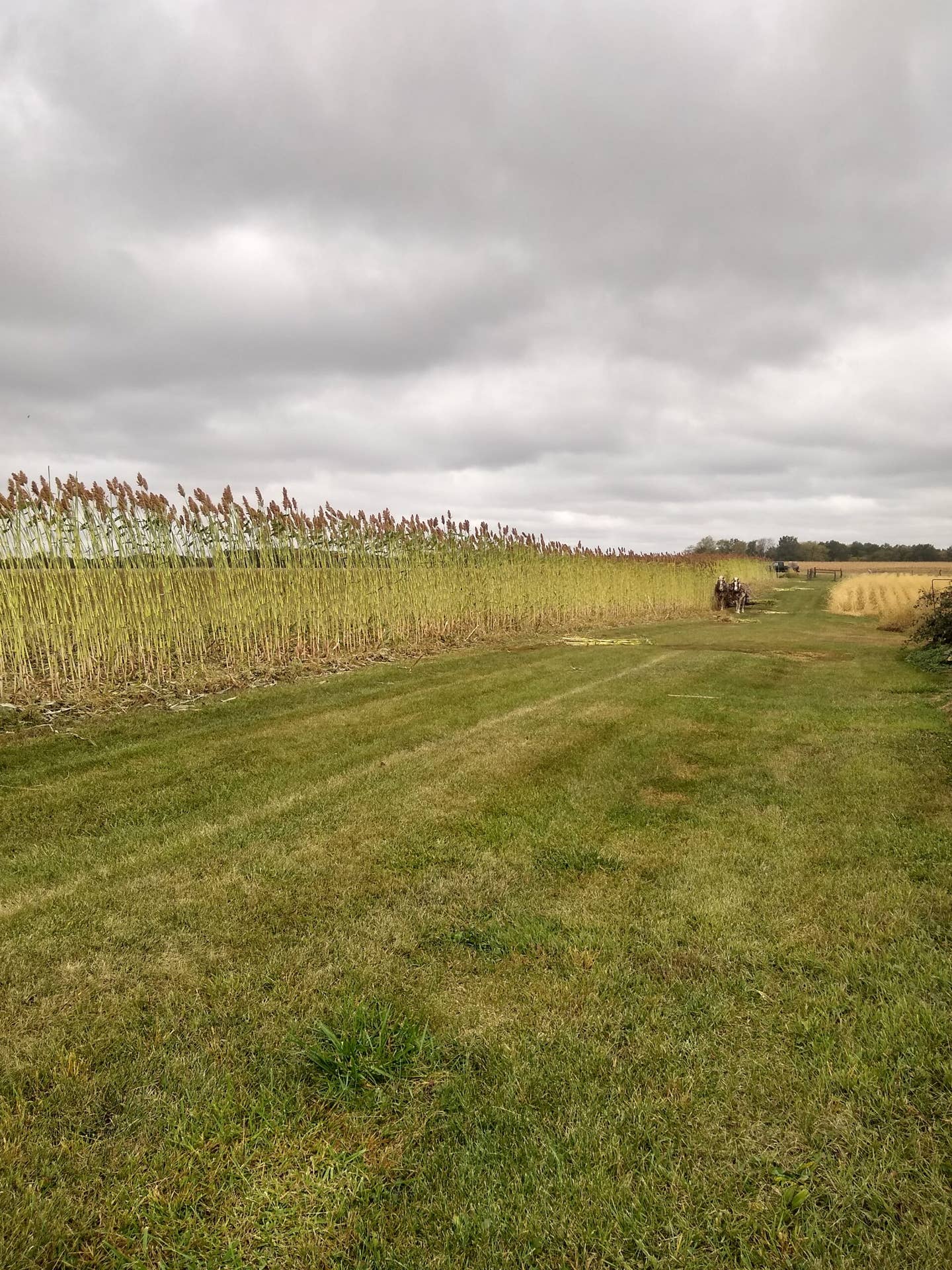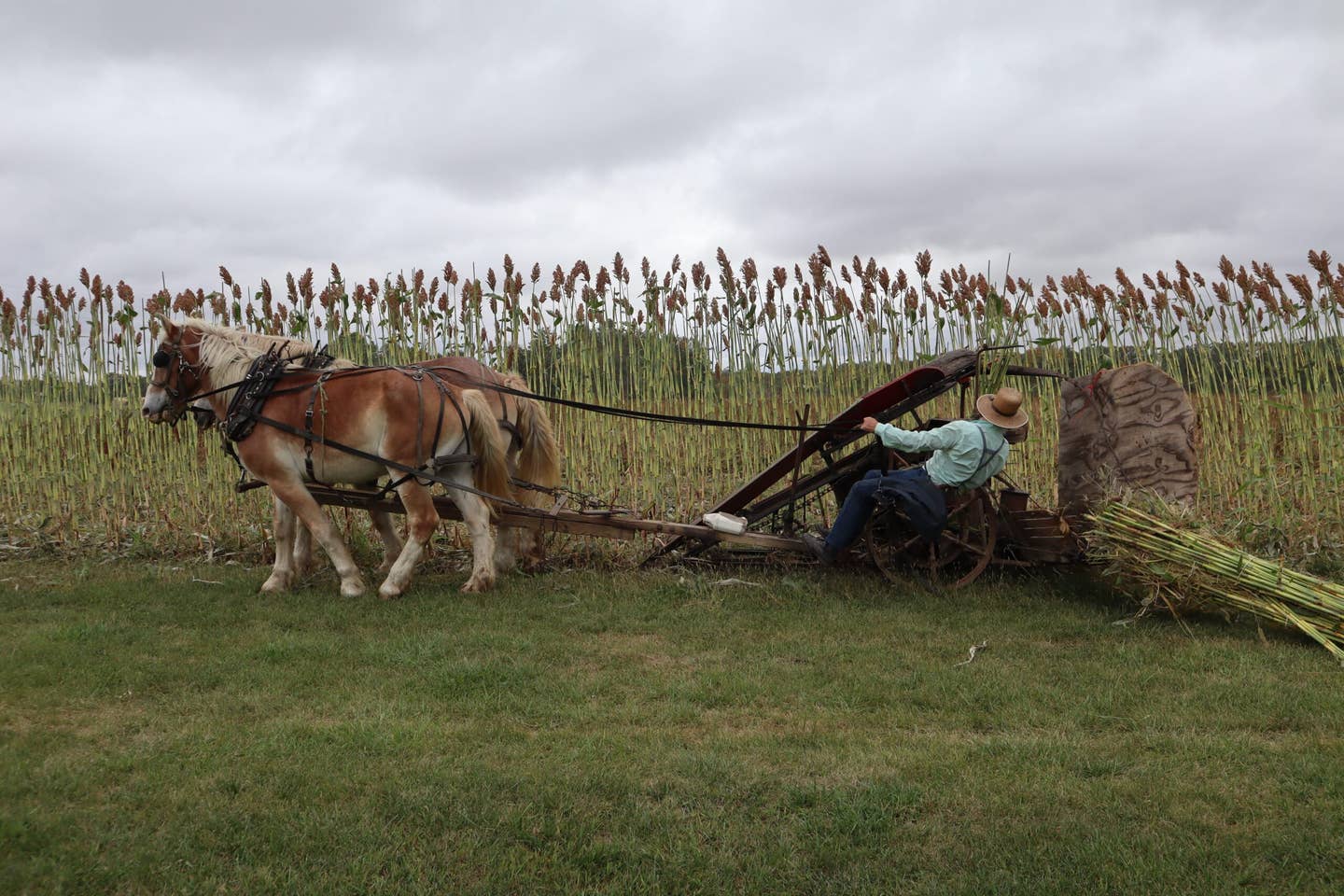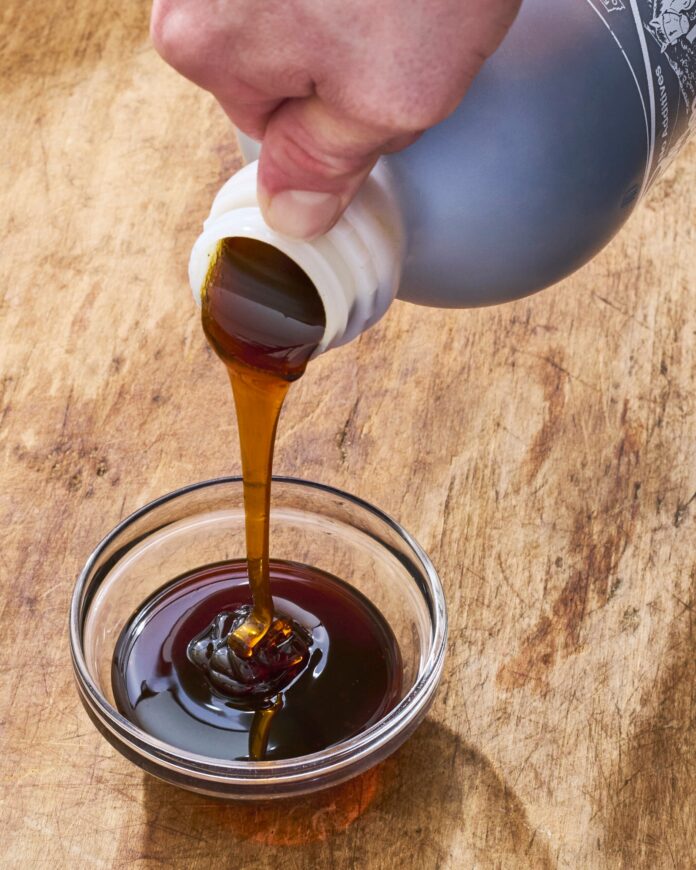Nancy Huber doesn’t feel the need to raise her voice. It carries clearly enough above the clank of the old cane press’s spinning shafts and rattling chains, which are currently wringing the juice out of sorghum stalks. But as I feed another bundle of stalks between the rolling metallic cylinders, I can make out her saying, “If your hand gets in there, you’re finished.” Sheave by sheave, I’m careful not to become some cautionary tale. I keep my sleeves well away from the mouth of this press, which has surely milled fields upon fields of sorghum cane in the century since it was manufactured.
None of the Huber sisters—not Nancy, Elva, Elizabeth, or Mary Ellen—speak very loudly. They all taught at the local Mennonite schoolhouse at some point, and recite their instructions the way a teacher might: kindly and matter-of-factly. But today, it’s me—a millennial farmer from outside the Anabaptist community with little sorghum know-how—who is their student. I’ve come to learn how to raise, harvest, press, and cook sorghum, a staple food here in Northeast Missouri. Judging by the stream of neighbors who show up while we work to buy a gallon or two of syrup, it’s clear the Huber sisters are known for making the good stuff.

In this largely rural region, it’s not uncommon to pass by small plots of cane sorghum, distinguished from grain sorghum (also known as milo) by their lengthy, corn-like stalk and thinner, smaller seedheads. Though cane sorghum isn’t as popular now as it was in its heyday, the crop maintains a foothold in this region, where homesteaders cultivate it as a means of self-sufficiency. The Mennonite and Amish communities consider sorghum syrup not only a practical and reliable sugar crop—resilient even amidst drought and other environmental extremes—but also a link to family and community far and near, past and present.
Sorghum syrup became common in the American South during the Civil War, driven by tariffs on imported cane sugar, embargos on supplies moving along the Mississippi River, and Northern abolitionists’ boycott of the sugar trade for its reliance on enslaved people’s labor. Propelled further by advances in seed breeding, the sorghum plant—which could be turned into syrup, grain, textiles, and even broomsticks—surged in popularity. However, not long after the necessity of subsistence agriculture faded during post-Civil War urbanization and industrialization, so too did sorghum. Despite its adaptation to northern climates, it still required more labor than cane or beet sugar, and was less productive. Not to mention, sorghum syrup has what some might consider an acquired taste.
This syrup isn’t quite like the floral, vanilla-y nectar that comes from maple or agave. The muddy, green pressed juice, when cooked to a caramel brown, is sweet, but with notably grassy, smoky undertones. It cannot be refined to a granulated form, so the finished product resembles a gooey treacle, with a green-brown hue. The first time Elizabeth Huber tasted it, she wasn’t an immediate fan. “Our uncle down in Kentucky brought up a barrel of stuff he overcooked. It was dark and burnt,” she recalls. But at the time, the Huber family was trying to eliminate white sugar from their diets. After a few years of purchasing their uncle’s syrup, they decided to start producing it themselves. Many Amish and Mennonite families incorporate the syrup into cookies, cakes, and quick breads, which infuses the desserts with herbaceous, earthy depth of flavor. People drizzle it on biscuits, popcorn, and oatmeal, or mix it with cream cheese and peanut butter for a rich, nutty dip—which the Huber sisters offered me alongside their famous homemade pretzels. It also finds its way into ham glazes, baked beans, barbecue sauces, and other cornerstones of heartland cuisine.

Today, sorghum production is stewarded almost entirely by Anabaptist communities—who value the thrift and self-sufficiency of making sweetener from scratch—throughout the South and Midwest. Local sorghum production in Northeast Missouri, once buoyed by robust agrarian communes like Sandhill Farm and small-scale home producers, is today just a shell of its former stature. The old cane press up at Sandhill has not crushed sorghum in years, and the fields that once bustled with teams of machete-wielding harvesters are now quiet tracts of dormant grass leased for hay. My neighborhood food cooperative got a five-gallon bucket of Sandhill’s last batch, and after stretching it out among numerous home-canned tomato sauces, stir-fried dishes, and pancetta and guanciale cures, there’s barely an inch left in the last pint jar. Increasingly, I’ve feared losing this sweet and humble provision.
And so I’ve come to help out the Huber sisters with their sorghum harvest, in hopes of learning how it’s done. As I walk the rows with a sharpened stick stripping the leaves from each plant, I trail three Mennonite girls—children of one of the Huber sisters—and can scarcely keep up. The diminutive Nancy comes over and demonstrates the proper technique: With one swift up-and-down motion, she deftly and firmly severs each leaf from the stalk. “If you’re smart, you can sometimes do it all in one movement,” she says, twisting the cane so the leaves line up. With one fluid strike, several leaves fall to the ground in unison.
Thrashing through the field, I do my best to stay in earshot and learn about when the sugar is ripe for harvest, how to best space the planting, how to properly weed, and other practicalities of sorghum cultivation. When I stop to catch my breath, I spy through the foliage (which is progressively thinning as we continue to work) a three-story brick house with an attached bakery and sewing-machine repair shop. In addition to producing sorghum, the Huber sisters drive the Amish school van, bake the best pretzels in the area, perform seamstress work, sell books and bibles, adopt children, practice midwifery, and apparently build homes and cabins. When I ask how old the brick house is, Nancy replies that she and her sisters built it in 2005: “We laid all those bricks ourselves.”

On harvest day, an Amish neighbor with a team of horses runs an old cornbinder through the field. “I saw he had one, and when I asked if he’d be willing to come harvest our sorghum with it, he perked right up. He said he’d been looking for some sorghum,” Nancy tells me. As the horses trot through the field, occasionally craning their necks to bite a juicy stalk, their driver perches carefully atop the clanking implement and reaches back once in a while to push heavy bundles of cut stalks off the back to be collected later. Once the cutting is complete, we heave the bundles into a wagon, trim off the seed heads, and haul the harvested sorghum away in carts. Some hours later, the Hubers realize this might be the heaviest yield they have ever raised.
As an ecology-minded farmer with a keen interest in crops that can handle increasingly hot, dry Midwest summers, I am impressed with sorghum’s climate resilience. Long known among farmers around the world for its tolerance of extreme heat and extended dry periods, sorghum also handles periodic inundation from heavy rains, suffers from fewer pests, and requires substantially less fertilizer than most other crops. In recent years, a growing number of agronomists and scientists have set their sights on sorghum as a climate-smart crop. As Nancy puts it, “it’s something nice to rely on.”
When I came to Northeast Missouri over a decade ago, our local dry-goods store always carried at least a few different options of sorghum syrup. Since then, many of the old brick buildings that once housed family-owned businesses have collapsed, and the available syrup is only stocked at stores further afield. Now, standing near the rapidly boiling pan of green juice in the Hubers’ sugar shack, where the autumn air is laced with caramel and woodsmoke, I am eagerly anticipating refilling our syrup pail. “You’ll see how the bubbles go from being foamy to getting thicker,” says Elva, advising me on how to use my senses to determine when the syrup is ready. “And it starts to sound different, like a buzzing.”
I’ve been having a hard time watching this process die. Our county still has no stoplights, but it is modernizing in other ways, like two recently opened Dollar General stores. These changes are an ever-creeping reminder that the old times are gone, and along with them, the need to provision our own sugar; it’s simply too easy these days to procure refined sweeteners imported from countries where labor and resources are cheaper. Every year, fewer and fewer weedy patches of sorghum cane spring from the ditches. Resplendent and pale green on the edges of cornfields, sorghum tends to get planted by seed-carrying birds, and a patch or two on some remote road usually signifies there was once a field of it nearby. Filled with sweet juice ‘til the day they are cut, sorghum stalks keep clinging on in the Northeast Missouri landscape.
When I ask the Huber sisters why folks aren’t raising and cooking sorghum as much anymore, Elva considers the question. She finally says, “I guess it’s too much work. My sisters want to keep on with it, but I don’t know if they can, once my kids leave.”
As the local-food movement continues across the U.S., I’m hopeful that more and more growers and eaters alike will seek out what remains of this precious tradition. Still, I’m mindful that it will take a significant surge of demand—and a wave of farmers willing to pick up the torch—to revitalize syrup production.
Before I leave the Hubers’, Nancy offers me some seeds. I can’t say if I’ll ever become as adept a sorghum cultivator as they are, but I do know one thing: come springtime, I’ll be sowing them along those backroad ditches.






